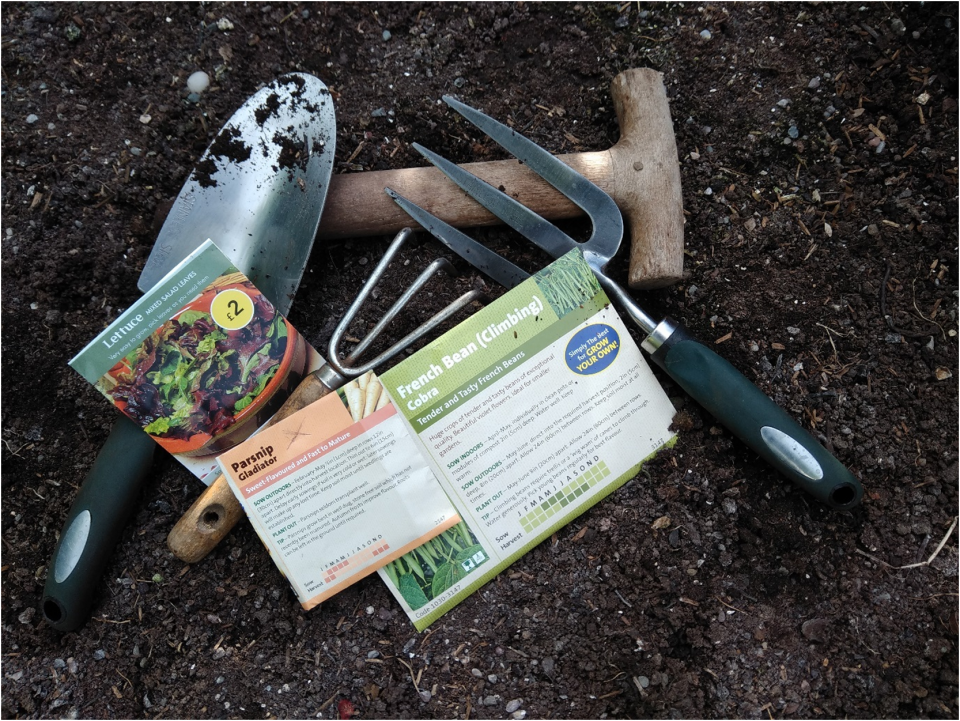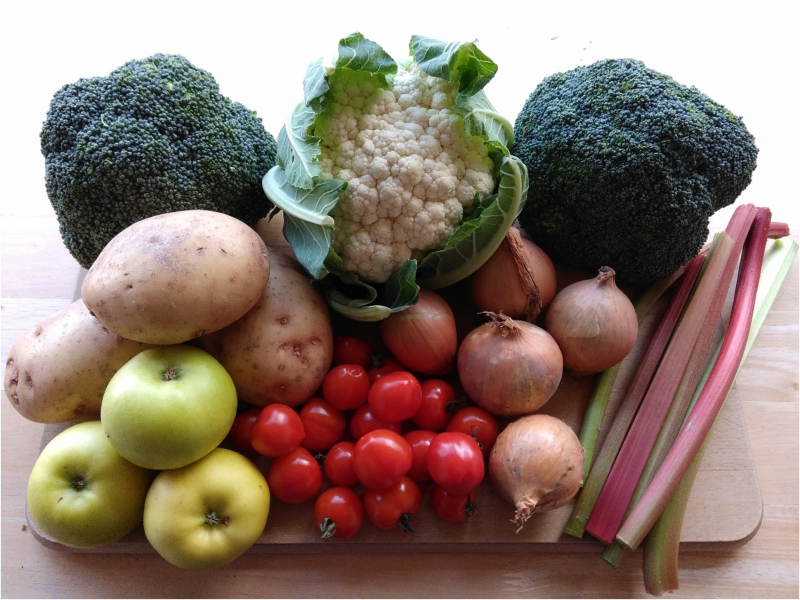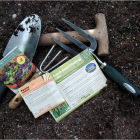There are a number of initiatives that fall under the umbrella of the community food movement. In the United Kingdom (UK) context, these include farmers’ markets, box schemes, city farms, allotments, urban gardens, food cooperatives, community-supported agriculture, community orchards, and local food directories. These enterprises are small scale and are organized on a local level around the issue of growing and producing food.

Community food movement initiatives provide opportunities for those who wish to grow their own fruit and vegetables.
Community food movement initiatives provide opportunities for those who wish to grow their own fruit and vegetables.
Photograph by Catherine Price.
 This work is licensed under a Creative Commons Attribution 4.0 International License.
This work is licensed under a Creative Commons Attribution 4.0 International License.
According to the New Economics Foundation (2009), three issues led to the increased interest in local food throughout the UK during the 1980s and 1990s. Firstly, there were environmental concerns surrounding industrialized agriculture. These include the use of chemicals (e.g., pesticides and insecticides), loss of habitats and biodiversity, soil erosion, and water pollution. Secondly, there were a series of food scares. These included salmonella in eggs (1988), and the crisis surrounding bovine spongiform encephalopathy (BSE) in cattle which was linked to variant Creutzfeld-Jakob disease in humans during the 1990s. Concerns surrounding the consumption of genetically modified foods came to prominence in the late 1990s, but these continue to divide opinion. Thirdly, local food is an area of resistance against the globalization of the food system. In recent decades, the UK food system has been influenced by global trade, with its reach even extending to “fresh” products such as fruit and vegetables, and milk. Oligopolies in the food industry include agribusiness, food processing, retail, and the food service sector. In addition, most local food is grown organically and as a result, no chemicals are used in its production. There is no reliance on the use of pesticides and insecticides, and synthetic fertilizers. Consequently, growing practices center on those which do not damage soil, water, or other natural resources. The emphasis is on working with the environment to produce food whilst also protecting biodiversity and maintaining ecosystems. The community food movement continues to flourish in the UK as some consumers resist globalized food supplies.
Allotments are used for noncommercial growing of food and flowers, and plots are typically rented to individuals by local authorities. Plots are clustered together in groups which range from small sites with 20 plots to very large sites with a few hundred plots. During the 1960s, allotments suffered from an image problem due to their association with the Second World War and wartime austerity. The 1970s brought renewed interest in allotments and other forms of urban food growing. Howe et al. (2005) contend this was due to environmental concerns, with people wishing to become more self-sufficient, and this in turn led to greater awareness of urban food production in the form of allotments, urban farms, and community-garden movements. In one respect, allotments provide accessibility for people who would otherwise be unable to grow crops. Crouch (2005: 127) argues that allotments are “more friendly and accessible to people who wish to work with the land than the genuine contemporary countryside of agri-business, the social exclusivity of range-rover culture and the ‘rural way of life’ out in the green belt.” However, there can also be exclusion, with growing restricted to those who are able to access tenancies. As Crouch (2005) contends, early comers are able to establish exclusive rights to occupation.

A selection of fruit and vegetables which can be found in a vegetable box. These vary depending on the season.
A selection of fruit and vegetables which can be found in a vegetable box. These vary depending on the season.
Photograph by Catherine Price.
 This work is licensed under a Creative Commons Attribution-ShareAlike 4.0 International License.
This work is licensed under a Creative Commons Attribution-ShareAlike 4.0 International License.
Community growing projects are an alternative to allotments. Firth et al. (2001: 557) define communities as being “built by community members who are engaged, participate and feel capable of working through problems, supported by strong social networks. In these terms, strong communities are defined as those endowed with social, economic and environmental assets, supported also by organizational structures that work towards their use over the long term in an equitable manner.” Kentish Town City Farm, in North London, began in 1972 and is situated on a four-acre site. It provides children and families with the opportunity to learn how to grow and cook food, look after animals, as well as connecting people to nature and the environment (Kentish Town City Farm, 2018). Incredible Edible was formed in Todmorden, a small town in the north of the UK in 2007. The group was formed by individuals who wished to improve their community, and the way in which they believed this could be achieved was through food. They began by planting edible crops in community plots and then went on to create the Incredible Farm and the Incredible Aqua Garden. There are now more than one hundred Incredible Edible groups in the UK, and the initiative has spread globally, including to countries such as New Zealand and Canada, following the formation of the Incredible Edible Network in 2012. This network aims to promote sustainable food production and consumption whilst also supporting the various Incredible Edible groups (Incredible Edible Network, 2018).
To successfully challenge globalized and industrialized agriculture, the various initiatives described here require scaling up. However, producing food where it is to be eaten, or consuming food where it is grown, initiates a sustainable, local food system. This may be the future of food growing and could enable cities to be productive in environmental, sociocultural, and economic terms. Initiatives such as Kentish Town City Farm and Incredible Edible illustrate the possibilities available for urban spaces. Allotments and community growing projects provide a means for people to come together to grow their own food. Additionally, considering the history of the community food movement may help address future food needs.
How to cite
Price, Catherine. “The Community Food Movement in the United Kingdom: 1960s to Present.” Environment & Society Portal, Arcadia (Autumn 2018), no. 30. Rachel Carson Center for Environment and Society. doi.org/10.5282/rcc/8382.
ISSN 2199-3408
Environment & Society Portal, Arcadia
 This work is licensed under a Creative Commons Attribution 4.0 International License.
This work is licensed under a Creative Commons Attribution 4.0 International License.
2018 Catherine Price
This refers only to the text and does not include any image rights.
Please click on an image to view its individual rights status.
- Crouch, D., and R. Wiltshire. “Designs on the Plot: The Future for Allotments in Urban Landscapes.” In Continuous Productive Urban Landscapes: Designing Urban Agriculture for Sustainable Cities, edited by A. Viljoen, 124–31. Abingdon: Routledge, 2005.
- Firth, C., D. Maye, and D. Pearson. “Developing “Community” in Community Gardens.” Local Environment 16, no. 6 (2011): 555–68.
- Howe, J., K. Bohn, and A. Viljoen. “Food in Time: The History of English Open Urban Space as a European Example.” In Continuous Productive Urban Landscapes: Designing Urban Agriculture for Sustainable Cities, edited by A. Viljoen, 95–107. Abingdon: Routledge, 2005.
- Incredible Edible Network. Accessed 20 April 2018. http://incredibleediblenetwork.org.uk.
- Kentish Town City Farm. Accessed 20 April 2018. http://ktcityfarm.org.uk.
- New Economics Foundation. “Reframing the Great Food Debate: The Case for Sustainable Food.” Accessed 19 April 2018. https://www.food4families.org.uk/userfiles/resources/nef-re-framingthegreatfooddebate-thecaseforsustainablefood.pdf.








